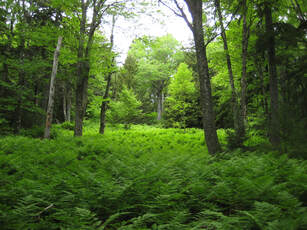 Acadian Forest. Image by Deborah Carr
Acadian Forest. Image by Deborah Carr The Fundy region boasts a number of trees and plants typical of the Acadian Forest. While early European settlers to the area used the native trees primarily for building ships, Indigenous peoples have traditional and medicinal uses for almost every plant that grows in the region.
The Red Spruce is a predominant tree in the Fundy region. Spruce gum – older, dried resin on the outside of the tree – was used by Indigenous peoples to patch holes and leaking seams in birch bark canoes or containers, and it also has medicinal properties. Spruce gum tea was used as a remedy for sore throats and upset stomachs, and the gum can also be made into a salve to heal cuts, sores, and rashes. Today, Red Spruce is the preferred wood in the making of stringed musical instruments.

The Balsam Fir is New Brunswick’s provincial tree, and was universally used by all Indigenous peoples in North America. Similar to Red Spruce, its resin has a wide array of medicinal properties, such as a treatment for all kinds of cuts and burns, and as a remedy for colds, coughs and asthma when applied as a salve to the chest. The needles were used to make pillows, as the aroma was believed to promote good health. Today, Balsam Fir is the tree most commonly used for Christmas trees.
Yellow Birch Betula alleghaniensis
The Yellow Birch is a long-lived tree native to New Brunswick. Indigenous peoples used the bark as a building material in the same way they used Paper Birch bark. A decoction made from the bark has cleansing properties, and was used by Indigenous peoples as a blood purifier. The Yellow Birch is a favourite food of white-tailed deer, and is an important source of hardwood lumber.
Paper Birch Betula papyrifera
The Paper Birch is native to the park, although not as common as the Yellow Birch. Indigenous peoples used Paper Birch bark as material to build a great number of things – from baskets to their famous birch bark canoes. They also used the bark to wrap and store food, and drank the sap as a medicine for colds. Today, this tree is harvested primarily for pulp.
Striped Maple Acer pensylvanicum
Striped Maple is a relatively common native tree in New Brunswick, although they are sparsely distributed in the Fundy region. It is a small tree with limited uses, especially in comparison to its relative the Sugar Maple. Indigenous peoples in Canada reportedly used the wood to make arrows, and boiled the bark to make a beverage. Striped Maple is also called Moosewood because it is an important food source for moose and deer, especially in the winter.
Tinder Polypore Fomes fomentarius
Tinder Polypore is a fungus that grows most commonly on birch trees – from New Brunswick, across North America, to around the world. It was used by Indigenous peoples in Canada in its dry and powdered form to stop bleeding, and was also recognized for its anti-bacterial and anti-viral properties. Tinder Polypore gets its name from its extremely flammable quality, and has been used as a fire starter by Indigenous peoples in Canada and European immigrants.
Tree Lungwort Lobaria pulmonaria
Tree Lungwort is a widely distributed lichen native to the majority of the northern hemisphere. Indigenous peoples in Canada would boil its leaves to make a tea that served as a remedy for many types of lung ailments such as coughs, asthma and bronchial infections. This tea was also used as an anti-inflammatory.
Old Man’s Beard is a lichen found worldwide that resembles grey-green tufts of hair. It is an effective natural indicator of air quality as the lichen is very sensitive to airborne pollutants. Indigenous peoples in Canada used the moistened lichen as a bandage applied directly to wounds, and scientific research has found that the lichen contains usnic acid, a very effective anti-bacterial and anti-viral agent.
Hammered Shield Lichen is one of the most common lichens in the world, and it grows primarily on the bark of trees and occasionally on rocks. Despite its global distribution, there are very few known uses for Hammered Shield Lichen. Some lichens of the same family are used as a spice in India.
 RSS Feed
RSS Feed